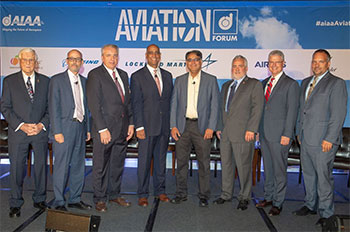Experts: Airspace Not Ready for Urban Air Mobility Written 27 June 2018
Panelists: Moderator Donald W. Richardson, chief operating officer, Donrich Research Inc.; Gregory Bowles, vice president for global innovation and policy, General Aviation Manufacturers Association; Ravi Chaudhary, director for advanced programs and innovation, FAA Office of Commercial Space Transportation; Parimal H. Kopardekar, senior technologist, Air Transportation Systems, NASA’s Ames Research Center; Robert Pearce, acting director, Airspace Operations and Safety Program, NASA’s Aeronautics Research Mission Directorate; Joseph A. Post, deputy director, FAA Systems Engineering and Integration Office; Richard Terry, director of line operations, Delta Air Lines; James Ullmann, director of safety and technology, National Air Traffic Controllers Association
by Ben Iannotta, Aerospace America editor-in-chief

The U.S. does not yet have a collaborative, integrated air traffic management system that can cope with the coming revolution in propeller craft that will whisk passengers over urban areas, said members of the “Air Traffic Management Modernization” panel June 27 at the 2018 AVIATION Forum in Atlanta.
“The user demands are getting more complex as [unmanned aircraft systems] and now air taxis and urban mobility concepts” want to enter the airspace, said Robert Pearce, acting director of NASA’s Airspace Operations and Safety Program. The FAA’s NextGen air traffic modernization initiative will address that demand, he explained, adding that “our job is to help by laying out that technology baseline.”
“As we go into these new paradigms, we need to bring in a much broader community,” Pearce said, referring to industry participation.
Richard Terry, director of line operations for Delta Airlines, cited “silos” of government responsibilities as a problem.
“We have to cut across them if we’re going to come up with an integrated plan,” he said.
One panelist said the integration problem has affected air traffic controllers, who need decision support tools to cope with expanding air traffic. Those tools “just don’t really exist,” said James Ullmann, director of safety and technology at the National Air Traffic Controllers Association, which represents the interests of controllers. He said the “stovepipes” of responsibility are one factor.
Ullmann cautioned that it’s also the basic infrastructure that must be considered. He made his case by showing photos of old computers and paper flight strips in a control tower.
“Something has to change. We have a lot of concerns,” he said.
Breaking those silos and stovepipes through collaboration will be critical to coping with the growing number and kinds of aircraft expected to maneuver through the National Airspace System, the panelists suggested.
Unmanned aerial systems and urban mobility aircraft are hot topics, but panelists also referred to supersonic jets, hypersonic test aircraft, balloons and spacecraft on their way to and from space.
The need to accelerate innovation and modernization of procedures came up several times in the discussion.
Ravi Chaudhary, director of advanced programs and innovation in the FAA’s Office of Commercial Space Transportation, said last fiscal year the FAA licensed 22 launch and reentry activities. Now, in the third fiscal quarter of 2018, FAA has already surpassed that number.
“We don’t expect that to show any signs of slowing down,” Chaudhary said.
Chaudhary said “regulatory humility” will be required to streamline licensing requirements as the pace of launches and recoveries increases. After the session, he added that “government does not always know best” and that innovations must be made at a faster pace.
Gregory Bowles, vice president for global innovation and policy at the General Aviation Manufacturers Association, expressed frustration about the pace of change in his industry.
“I operate in the [National Airspace System] day in and day out,” he said. “I understand how slowly we implement change.”
Bowles said unmanned aircraft are “knocking on the door, and we haven’t responded quickly enough.” He added that urban air mobility concerns are following close behind.
One panelist gave a specific example of the diversity of aircraft expected to ply the airspace and the complexities that this diversity raises.
Parimal “PK” Kopardeker, a senior technologist at NASA’s Ames Research Center in California, referred to industry plans to fly balloons at about 60,000 feet.
“Clearly what’s interesting there is supersonic [aircraft] operating on fixed trajectory, and the balloons will be lingering around,” he said. “We have models of that” to “keep everything apart and safe” by data sharing.
Joseph Post, deputy director of FAA’s National Airspace Systems Engineering and Integration Office, said safety is not just driven by traffic management. He referred to an accident in New York City involving an aircraft attempting to land on top of a building: “That’s not an air traffic control problem,” he said.
